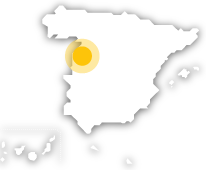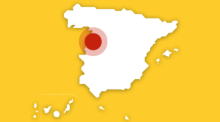Ciudad Rodrigo, listed as a historic and artistic site, is an outstanding fortified town located in the west of the province of Salamanca.
Its walls envelop a rich heritage of civil and religious buildings, with its cathedral and castle at the top of the list.
Ciudad Rodrigo's current site, a rocky hill on the banks of the Agueda River, has been inhabited since Neolithic times. Around the 6th century BC, the Vettones, a tribe of Celtic origin, founded the city of Mirobriga and settled there. Four centuries later, the Romans conquered the city, which was renamed Augustobriga, in honour of the emperor Octavian Caesar Augustus. The Tres Columnas, an enigmatic monument that still stands at the entrance to the city, bear witness to this period.After being the subject of disputes between Arabs and Christians for centuries, this stronghold was repopulated in 1100 by Count Rodrigo Gonzalez Girón, who gave it its definitive name. King Ferdinand II of Leon completed the repopulation of the area and undertook ambitious projects, including the fortification of the city and the restoration of the old Roman bridge. At the same time, under his reign it once again became an episcopal see, and work began on the cathedral.The main buildings in the old quarter, which has been declared a historic and artistic site, date from between the 15th and 16th centuries, when the city experienced a period of great splendour.
The walled city
The city's urban layout was definitively shaped by the imposing medieval wall that surrounds it. It was constructed in the 12th century during the reign of Ferdinand II, although it underwent subsequent remodelling in the 18th century. The walled enclosure has a perimeter of more than two kilometers and a total of seven gates, the oldest of which are Sol and Santiago.Through the Puerta de la Colada gate, you reach the hill on which the Enrique II Castle stands. The monarch ordered the castle's construction in 1372. This fortress is presided over by the tribute tower, with a square floor plan. It currently houses the town's Parador de Turismo.There are some stately buildings in the Plaza Mayor, such as the house of the Primer Marqués of Cerralbo, or Casa de los Cuetos (16th century), and the Town Hall. The latter was built in the mid-16th century in Renaissance style and has additions from the early 20th century. Its main façade has two emblazoned turrets and a gallery with Plateresque capital columns.The boom experienced by the town during the Renaissance led to the appearance of countless palaces and noble houses at every turn. One of the most outstanding is the Palacio de los Castro, with its beautiful Plateresque façade between Solomonic columns crowned by lion figures. The Palacio de los Aguila (16th-17th centuries) deserves special mention, a solemn mansion that displays the coats of arms of its former owners. The tour continues with a visit to the Palacio de la Marquesa de Cartago, a neo-Gothic palace from the 19th-20th centuries; the Palacio de Moctezuma, now the Casa de la Cultura; the Casa de los Vazquez, where the Post Office is located; and the Palacio del Conde de Alba de Yeltes.
Religious architecture
The Cathedral is the most important religious building in Ciudad Rodrigo. Its construction began around 1165 and was not completed until 1550, which is evidenced by a mixture of artistic styles. On its façade, of particular note is the Puerta de las Cadenas or Door of Chains, with a frieze featuring several sculptural reliefs. Inside, the temple is divided into three naves crowned with cross vaults. The main altar, in the apse of the central nave, is covered by a star-shaped vault, a work by Rodrigo Gil de Hontañón. Another element that catches visitors' attention is the choir stalls, on which there are some profane scenes carved by Rodrigo Aleman in 1498. You can also see the Diocesan Museum, which exhibits a collection of sacred art.Near the Cathedral is the Capilla del Marqués de Cerralbo, a magnificent chapel in the Herrerian style topped by a large cupola with a lantern tower. Inside, the church houses beautiful altarpieces made of walnut wood. There are other beautiful churches in the town centre, such as those of San Agustin (16th century), San Pedro (12th century) and the Capilla de las Franciscanas Descalzas (17th century). On the outskirts, heading towards the Agueda reservoir, is the 16th century Monastery of La Caridad.
Surrounding area, festivals and gastronomy
Ciudad Rodrigo is located in a region full of tourist attractions. The town lies at the foot of the Sierra de Gata mountain range, which can be reached by following the course of the Águeda River until you reach villages such as El Bodón, El Payo and Fuenteguinaldo. In the surrounding area, you can visit the pre-Roman settlements of Irueña and Lerilla, both declared historic and artistic monuments.In the southeast of the province, in the region of the Sierra de Francia, there are other must-see spots, such as La Alberca, a town declared as a national historic monument, and Miranda del Castañar, a historic and artistic site; as well as natural locations such as Peña de Francia and the Batuecas Valley.Farinato (sausage made with breadcrumbs, pork fat, paprika and spices) is the most typical speciality of Mirobrigian cuisine, best accompanied by fried eggs. Other local dishes worth mentioning include chanfaina (made with rice and pork), hornazo (a type of empanada) and roast meats, especially suckling pig. As for pastries, try the bollo maimón (a cake made with sugar, eggs and yeast) and repelao (a sweet with a flavour similar to marzipan, made throughout the whole region).As for the festivals, one of the ones that the locals of Ciudad Rodrigo most eagerly await every year is the Bull Carnival. This event, as its name suggests, is all about bullfighting. For a number of days, the Plaza Mayor becomes the stage for bullfights and other festivities.
















